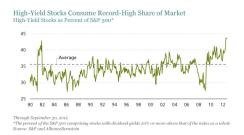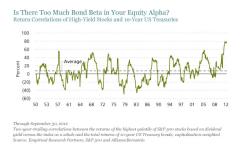The phenomenal popularity of high-dividend-paying stocks since the financial crisis is understandable. Their reliable, bond-like income and defensive qualities offer at least some certainty in an uncertain world. But investors may not be as safe as they think.
The widespread pursuit of safety in high-yielding stocks has driven up their valuations and increased market concentration in these stocks. It has also caused an alarming surge in their correlation to bonds, so investors may be getting a lot less diversification than they realize.
Let’s look at valuations first. High-yield stocks are as pricey as they’ve been since the early 1950s, trading at a modest premium to the market versus a long-term average discount of 20 percent. We don’t view this premium as exorbitant given the current market anxieties but it does limit upside potential and makes these stocks more vulnerable than others if sentiment turns. Most of the high-priced dividend-paying stocks are in mature, slow-growth sectors such as consumer staples, telecom and utilities, which are likely to look less appealing than more economically sensitive stocks in a sustained economic recovery.
What’s more, high-yield stocks now account for a much bigger share of the market, elevating the risk that arises when the market becomes overly concentrated in an overpriced subset — such as technology stocks in the late 1990s. In the U.S., where this trend is most pronounced, stocks with yields 20 percent or more above the market’s now account for 44 percent of the S&P 500 index on a cap-weighted basis. That’s their highest share in the last three decades and well above the historical average of 36 percent, as shown in the first display, below.

More menacing is the extent to which high-yielding stocks are behaving like bonds. Correlations between the relative returns of the highest-yielding S&P 500 stocks and total returns of 10-year US Treasuries have soared to 80 percent on a two-year-trailing basis. That’s more than 11 times its historical average of 7 percent and, as shown in the second display, below. That’s the highest it’s been in more than 60 years. This means high-yield stock investors may be far more exposed to bond-market risks — such as an eventual rise in interest rates — than they want to be.

Investors need to understand the growing risks of overplaying the defense card. As a countermeasure, they may want to add more cyclical, deeper-value names that have been lagging on doubts about the economic recovery and future earnings. In our view, these will also enhance their equity alpha potential. When recovery comes, we expect these overly cheap stocks, many of them in better financial shape than before the crisis, to lead.
Investors who are passively invested in cap-weighted indices should pay attention to these trends, too, because the market is embedding the growing dangers of overexposure to expensive safety stocks and the higher-than-usual correlations to the bond market. Active investing strategies, backed by research, can take advantage of the opportunities these distortions create — and can avoid some of the risks.
The views expressed herein do not constitute research, investment advice or trade recommendations and do not necessarily represent the views of all AllianceBernstein portfolio-management teams.
Joseph G. Paul is chief investment officer of North American Value Equities at AllianceBernstein.





